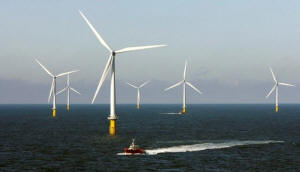|
Wind power's big bet: turbines taller
than skyscrapers
 Send a link to a friend
Send a link to a friend
 [June 28, 2017]
By Stine Jacobsen and Vera Eckert [June 28, 2017]
By Stine Jacobsen and Vera Eckert
COPENHAGEN/FRANKFURT (Reuters) - Wind farm
operators are betting on a new generation of colossal turbines, which
will dwarf many skyscrapers, as they seek to remain profitable after
European countries phase out subsidies that have defined the green
industry since the 1990s.
The world's three leading offshore wind operators - DONG Energy, EnBW
and Vattenfall - all told Reuters they were looking to these
megaturbines to help adapt to the upcoming reality with dwindling
government handouts.
According to interviews with turbine makers and engineers, at least one
manufacturer - Siemens Gamesa - will have built a prototype megaturbine
by next year and the first farms could be up and running in the first
half of the next decade.
These massive machines will each stand 300 meters tall – almost as high
as London's Shard, western Europe's tallest building - with 200-metre
rotor spans that will stretch the length of two football fields.

The wind power sector is at a critical juncture as the subsidies that
have cradled it since its inception in the early 1990s, and underpinned
its business model, disappear as politicians enact a long-planned push
to make the industry more commercially viable and able to compete with
other energy sources.
The countries that form the hub of the European offshore wind industry -
Denmark, Germany, the Netherlands and Britain - are looking to gradually
phase out the handouts over the next decade. This will end a crucial
source of revenue for operators; in tenders concluded as recently as
2014, subsidies still accounted for around half of European wind
projects' income.
With the writing on the wall, DONG and EnBW submitted bids with no
subsidies factored in at a tender in April for a German project planned
for 2024. The auction represented an industry milestone, the first with
zero-subsidy bids, but raised the burning question of how operators will
be able to make money and survive while offering a commercially
attractive alternative to coal and nuclear.
The answer, according to the companies, are the megaturbines, which
would sweep a far bigger area and harness more wind, cutting costs per
megawatt. They will each generate between 10 and 15 megawatts (MW) of
power - a considerable leap from the largest turbines currently in
operation, made by MHI Vestas, which are 195 meters tall and generate 8
MW.
The megaturbines are no sure bet for the companies' bottom lines,
however.
There are challenges on the technical front to create monumentally tall
towers and light, slender blades that can withstand the strain of
gale-force winds.

Economically, there are also doubts among some industry experts about
whether zero-subsidy wind projects can make money, even with the
increased efficiency delivered by megaturbines.
They say deeper savings must be made by operators across their
businesses and electricity prices must also rise significantly to bring
profitability.
Michael Guldbrandtsen, offshore wind consultant at MAKE, said there were
financial and technical risks associated with megaturbines, but that
operators had little choice but to invest in a technology needed to make
zero-subsidy projects viable.
"Without a significant increase in the size of turbines it would not be
possible to ensure a reasonable return," he added.
PROTOTYPE MEGATURBINE
Operators are nonetheless banking on the new technology.
Michael Simmelsgaard, head of offshore business at Swedish utility
Vattenfall, said the industry would cross the 10 MW turbine threshold
"faster than many expect now", without being more specific. A 10 W
turbine could power about 9,000 homes.
"We will definitely see these big turbines," he added.
DONG Energy's wind business, Samuel Leupold, laid out more ambitious
plans: "We believe we can utilize (turbines) in the range of 13 to 15
megawatts," he said on the sidelines of an offshore wind conference in
London this month - the first time an industry executive has given such
a high figure. Previously, companies have only spoken about turbines in
the region of 10W.
EnBW also said it was turning to megaturbines.
"Size is an important driver of efficiency," said Dirk Guesewell, its
head of generation portfolio development. "Bigger rotors mean fewer
turbines and foundations are needed to achieve the same capacity."
[to top of second column] |

A crew boat passes through Horns Rev 2, a wind farm off the west
coast of Denmark near Esbjerg September 15, 2009. REUTERS/Bob
Strong/File Photo

German turbine maker Senvion said it was developing megaturbines of
over 10 MW. While the machines are still in the design stage, it
said it was already offering them for future use to wind farm
operators.
"We envisage that the installations of those wind farms will take
place in the first half of the next decade," head of Senvion's
Global Offshore business, Cornelius Druecker, told Reuters without
saying how close the firm was to a prototype.
An independent engineer working with Siemens Gamesa, who asked not
to be named as they are authorized to speak publicly, said the
German company will have built a prototype megaturbine by next year.
Another engineer, who works with several big turbine makers, said
designs had almost been completed across the sector and the process
of producing prototypes was about to start.
Siemens Gamesa declined to comment.
TECHNICAL HURDLES
The biggest technical hurdle involves increasing the length of the
turbine blades without putting too much strain on the structure
which is built on a platform fastened to the seabed.
With spans of around 200 meters, the blades will be about 50 meters
longer than those of the most powerful turbines now in operation.
As they are constantly exposed to different levels of wind, their
construction, which requires adhesives that join different layers of
carbon or glass-fiber to dry at exactly the right temperatures, is
extremely complex.

Denmark's state research institute DTU Wind Energy, which has
propelled much of the innovation in wind power, is working on
keeping down the weight of these super-long blades by bumping up the
carbon fiber content. They have designed blade features similar to
the flaps on aeroplane wings to control and reduce load variations
so turbulence does not break the blades.
"Most people understand it is complicated to make calculations on an
airplane or a helicopter, but turbines are at least as complicated
and it is the same methods we use," said Flemming Rasmussen, the
institute's head of aerodynamic design.
When mass production begins, new factories will be needed with
enough space for the blades.
DO NUMBERS ADD UP?
No operator is prepared to publicly disclose the calculations and
projections that underpins its strategy, citing commercial
sensitivity.
Even with megaturbines in place, the operators would also need other
things to go their way to turn a profit without state subsidies -
crucially, electricity prices must rise to a level where
profitability outstrips investment costs.
Bernstein researchers calculated that, at their current power price
forecast, operators would need to reduce their capital expenditure
(capex) by around 60 percent for zero-subsidy projects to break
even. Increasing turbine sizes from 7 MW to 14 MW would reduce capex
by around 40 percent, they added.
The researchers expect a 5-6 euros a megawatt hour (MWh) rise from
current power market prices of 30 euros/MWh by 2023.

"Cost reductions and power prices will have to be consistently much
higher than our predictions for the subsidy free projects to break
even," they said.
(For a graphic on giant wind turbines, click
http://tmsnrt.rs/2scy0jG)
(Reporting by Stine Jacobsen in Copenhagen and Vera Eckert in
Frankfurt; Additional reporting by Karolin Schaps, Susanna Twidale
and Nina Chestney in London, and Alissa de Carbonnel in Brussels;
Editing by Tom Pfeiffer and Pravin Char)
[© 2017 Thomson Reuters. All rights
reserved.]
Copyright 2017 Reuters. All rights reserved. This material may not be published,
broadcast, rewritten or redistributed. |